Olga's Gallery
Dear Friends of Art,
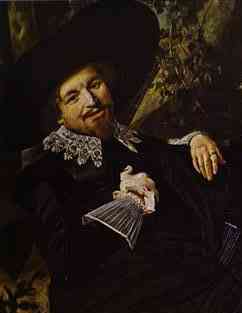 During
the past two weeks we have published the collections of several Dutch painters,
among them, Frans Hals, his younger brother
Dirck Hals, Gerard
Terborch, Jan Steen and Judith
Leyster. We would like to point out the Portrait
of Isaak Abrahamsz Massa and Beatrix van der Lean, by Hals.
Isaak Massa was a successful silk trader in Russia, where he lived from
1602 till 1609, he knew the Russian language and left an account of the
events of 1598-1609 in Russia, which he called “A Short Report about Moskovia
in the Beginning of the XVII century” and dedicated to Moritz, Prince of
Orange.
During
the past two weeks we have published the collections of several Dutch painters,
among them, Frans Hals, his younger brother
Dirck Hals, Gerard
Terborch, Jan Steen and Judith
Leyster. We would like to point out the Portrait
of Isaak Abrahamsz Massa and Beatrix van der Lean, by Hals.
Isaak Massa was a successful silk trader in Russia, where he lived from
1602 till 1609, he knew the Russian language and left an account of the
events of 1598-1609 in Russia, which he called “A Short Report about Moskovia
in the Beginning of the XVII century” and dedicated to Moritz, Prince of
Orange.
The Time of Trouble
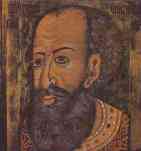
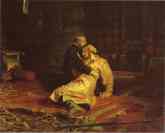 “Ivan
Vasilyevich, the Grand Duke of Moskovia, called ‘the Terrible’ for his
great cruelty, was born in the capital of the country, Moscow, in 1530,
in August,” Massa started his report. Ivan the Terrible was married
seven times and had three sons by different wives, Ivan, Feodor, and Dmitry.
The eldest, Ivan, who resembled his father, was already adult and married,
when in a passionate quarrel the tsar struck him with his staff and killed
him (1582). Thus, after the death of the tsar Ivan the Terrible (1584),
there were 2 sons left, Feodor and a child, Dmitry, son of the tsar’s seventh
wife, Maria (or Marfa) Nagaya.
“Ivan
Vasilyevich, the Grand Duke of Moskovia, called ‘the Terrible’ for his
great cruelty, was born in the capital of the country, Moscow, in 1530,
in August,” Massa started his report. Ivan the Terrible was married
seven times and had three sons by different wives, Ivan, Feodor, and Dmitry.
The eldest, Ivan, who resembled his father, was already adult and married,
when in a passionate quarrel the tsar struck him with his staff and killed
him (1582). Thus, after the death of the tsar Ivan the Terrible (1584),
there were 2 sons left, Feodor and a child, Dmitry, son of the tsar’s seventh
wife, Maria (or Marfa) Nagaya.
 “In the time of the tyrant Ivan Vasilievich, in Moscow, there lived the
Godunovs, a family of tatar origin. They have been living in Moskovia for
a long time, their ancestors entered the service of Vladimir’s dukes when
Vladimir was the capital of the country. From that family Feodor Ioannovich
took a wife… and she had a brother, Boris Godunov…”
“In the time of the tyrant Ivan Vasilievich, in Moscow, there lived the
Godunovs, a family of tatar origin. They have been living in Moskovia for
a long time, their ancestors entered the service of Vladimir’s dukes when
Vladimir was the capital of the country. From that family Feodor Ioannovich
took a wife… and she had a brother, Boris Godunov…”
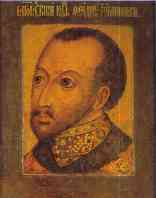 After
Feodor Ioannovich, the second son, became the tsar, he sent his step-mother,
Maria Nagaya, and step-brother, Dmitry, out of Moscow to Uglich. “When
the tsarina Marfa was in a convent, all other relatives of the Nagoys were
sent into exile. All the nobles talked about this but were afraid to go
against the Godunovs; but common people, merchants and others, gossiped
among themselves secretly that the Godunovs were traitors and aimed for
the throne… That is why Boris did everything to appeal to the people.”
Many foreigners, who saw tsar Feodor during audiences, said that they thought
him a complete fool. Isaak Massa put it more mildly, “the tsar resembled
more an ignorant monk than a grand duke, more than that he was remarkable
for his credulity and extreme gullibility – he believed everything Boris
told him… Boris was more respected than the tsar, because the tsar did
nothing but visit church and stand through all the divine services; while
Boris ruled all the country as its leader, while Fedor Ioannovich only
had the title.”
After
Feodor Ioannovich, the second son, became the tsar, he sent his step-mother,
Maria Nagaya, and step-brother, Dmitry, out of Moscow to Uglich. “When
the tsarina Marfa was in a convent, all other relatives of the Nagoys were
sent into exile. All the nobles talked about this but were afraid to go
against the Godunovs; but common people, merchants and others, gossiped
among themselves secretly that the Godunovs were traitors and aimed for
the throne… That is why Boris did everything to appeal to the people.”
Many foreigners, who saw tsar Feodor during audiences, said that they thought
him a complete fool. Isaak Massa put it more mildly, “the tsar resembled
more an ignorant monk than a grand duke, more than that he was remarkable
for his credulity and extreme gullibility – he believed everything Boris
told him… Boris was more respected than the tsar, because the tsar did
nothing but visit church and stand through all the divine services; while
Boris ruled all the country as its leader, while Fedor Ioannovich only
had the title.”
Though Massa sympathize with Boris Godunov, he had to admit that, “Meanwhile the country began to flourish, its population grew, as before then it had been almost depopulated and ruined by the great tyranny of the deceased Grand Duke and his military commanders… now thanks to the kindheartedness and gentleness of Grand Duke Fedor, and the great abilities of Boris, the country began to re-establish itself and become rich.”
On the 15th of May 1591, tsarevich Dmitry was found killed in the yard of his Uglich palace. The murderer was never found, but Godunov’s enemies gossiped that it was Boris Godunov; the rumor was spread among the people, and later many historians and authors shared that version, though there is still no proof and little evidence to that. Isaak Massa was among those who believed that Boris was the culprit.
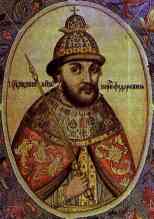 In
1598, tsar Fedor died childless. “After the death of the pious tsar Fedor
Ioannovich, the common folk, who are always ready to rebel in this country,
rushed to the Kremlin and asked Fedor’s widow to be their ruler,” but she
refused. Thus the Ryurik dynasty stopped. Then the nobility (boyars) chose
tsarina’s brother, Boris Godunov, as the Russian Tsar.
In
1598, tsar Fedor died childless. “After the death of the pious tsar Fedor
Ioannovich, the common folk, who are always ready to rebel in this country,
rushed to the Kremlin and asked Fedor’s widow to be their ruler,” but she
refused. Thus the Ryurik dynasty stopped. Then the nobility (boyars) chose
tsarina’s brother, Boris Godunov, as the Russian Tsar.
A talented ruler, Boris, however failed to suppress his enemies. In 1601-1605, the country was struck by natural disasters: freezing, floods, droughts, which were fatal both for the country and for Tsar Boris. As a result, hundreds of thousands of people died of famine, many towns and villages were empty. Massa writes, “At that time, by God’s will, famine struck the country. Even the famine described by Albert, abbot of Stadten, could not be compared with this one; so great was the famine and poverty in Moskovia that even mothers ate their children… All roads were strewn with people who had died of famine, and their bodies were eaten by wolves, foxes, and other beasts… this lasted for 4 years, almost till 1605.”
Boris’ enemies used the situation. They distributed the rumor that tsarevich Dmitry survived the attempted murder and would soon come to Moscow to recover the throne. As if to support the gossip, the miraculously resurrected tsarevich Dmitry appeared in Rech Pospolitaya (the kingdom that united Poland, Lithuania, part of Ukraine and Belorussia under the rule of a Polish king). He quickly obtained support from Polish magnates, the king, and representatives of the Catholic Church. They found him a noble bride – Marina Mnishek. Who was that adventurer? It is still difficult to say for sure. According to the most probable version, he was one Grigory Otrepyev, a monk from the Chudov convent. He received the support of some of the Russian boyars as well.
Massa wrote, “In Poland they knew everything what was going on in Moskovia; because many people moved there and entered the service of Polish nobles, e.g. pan Vishnevetsky, voevoda Sandomirsky and many others. Among those people was a lay brother of the Chudov convent; he had worked as a scribe and knew many secrets of the state; he knew much about Boris… In Poland he called himself Dmitry, the son of Ivan Vasilievich (the Terrible), whom Boris had ordered to kill but who had escaped.”
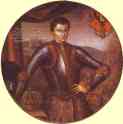 Using
a comfortable excuse, the ruling classes and clerical power of Rech Pospolitaya,
planned to capture Russia and state their power there. In Russia the sympathy
for the impostor rose; people wanted to see in him a just and kind ruler,
who would establish peace, public tranquillity and normal life in the country.
In 1604, False Dmitry I with the support of the Polish troops crossed the
Russian border. All dissatisfied with Godunov came to Dmitry, Russian cities
one after another took his side. The unexpected death of Boris Godunov
speeded to events. Godunov’s family was killed by the boyars and, in June
1605, False Dmitry I triumphantly entered Moscow. The tsarina, mother of
Dmitry, Maria Nagaya, had to recognize False Dmitry as her son. On becoming
the tsar he however made a number of mistakes, and the most serious was
that he surrounded himself with Polish nobles and clergy who tried to insert
Catholicism.
Using
a comfortable excuse, the ruling classes and clerical power of Rech Pospolitaya,
planned to capture Russia and state their power there. In Russia the sympathy
for the impostor rose; people wanted to see in him a just and kind ruler,
who would establish peace, public tranquillity and normal life in the country.
In 1604, False Dmitry I with the support of the Polish troops crossed the
Russian border. All dissatisfied with Godunov came to Dmitry, Russian cities
one after another took his side. The unexpected death of Boris Godunov
speeded to events. Godunov’s family was killed by the boyars and, in June
1605, False Dmitry I triumphantly entered Moscow. The tsarina, mother of
Dmitry, Maria Nagaya, had to recognize False Dmitry as her son. On becoming
the tsar he however made a number of mistakes, and the most serious was
that he surrounded himself with Polish nobles and clergy who tried to insert
Catholicism.
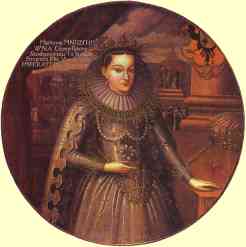 Meanwhile
False Dmitry’s bride, Marina Mnishek came to Moscow. Massa, who witnessed
the arrival of the bride and the wedding ceremony described it, “Marina
was dressed according to French fashion, her dress was of white atlas,
all in pearls and gems; opposite her sat two Polish countesses, her kin,
they were followed by many carriages with ladies and noble maidens, these
were magnificent carriages with gold poles, and each was pulled by six
or eight horses…” Then Massa described the splendid wedding ceremony, which
took place in one of the cathedrals, and which almost ended with tragedy,
because “Moscovites were outraged that Poles entered their church armed
and in hats, and if there was anyone to provoke them, they would have killed
everyone, because their church was defiled by the pagans, they call pagans
all people of the world, considering only themselves true Christians….
and in their blindness they are very sensitive about their faith…”
Meanwhile
False Dmitry’s bride, Marina Mnishek came to Moscow. Massa, who witnessed
the arrival of the bride and the wedding ceremony described it, “Marina
was dressed according to French fashion, her dress was of white atlas,
all in pearls and gems; opposite her sat two Polish countesses, her kin,
they were followed by many carriages with ladies and noble maidens, these
were magnificent carriages with gold poles, and each was pulled by six
or eight horses…” Then Massa described the splendid wedding ceremony, which
took place in one of the cathedrals, and which almost ended with tragedy,
because “Moscovites were outraged that Poles entered their church armed
and in hats, and if there was anyone to provoke them, they would have killed
everyone, because their church was defiled by the pagans, they call pagans
all people of the world, considering only themselves true Christians….
and in their blindness they are very sensitive about their faith…”
Though deprived of power, the local nobles still had real force and
did not miss the chance to punish “treacherous” Dmitry. In June 1606, they
started unrest. The rebels stormed the Kremlin and killed False Dmitry.
There were Polish pogroms all over the city, and many foreigners suffered;
they were robbed and many were killed. Massa gives a detailed account of
the pogroms, which even 300 hundred years later is horrible to read.
“Once, when it was not dangerous already I
left the house to see the killed, especially the two corpses of False Dmitry
and his friend Basmanov.”
To be continued...